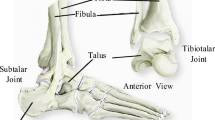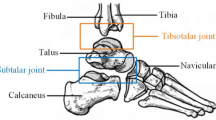Abstract
Based on the analysis of existing ankle rehabilitation devices, a new ankle rehabilitation mechanism based on 3-UPU parallel mechanism is proposed in this paper. The mechanism has three degrees of freedom, and can achieve ankle pronation/supination, inversion/eversion, and stretch movement. The rotation axis of the mechanism can be adjusted according to the ankle height and the position of the movement axis of the human body. In this paper, the inverse kinematics and DOF of the mechanism are solved. According to the ankle rehabilitative requirements, the size of the mechanism is determined, and the workspace of the mechanism is further solved. Finally, the kinematics of the mechanism is simulated and verified by the prototype. Therefore, the rotation axis of the mechanism can match with the motion axis of the human ankle joint better and bring better rehabilitation effects to the patients.
Access this chapter
Tax calculation will be finalised at checkout
Purchases are for personal use only
Similar content being viewed by others
References
Yong Z, Gang W (2015) Advances in biomechanics and kinematics of ankle sprai. China J Orthop Traumatol 28(4):374–377
Jifeng R, Yi W, Ling G et al (2015) Research progress of foot ptosis and foot varus rehabilitation in stroke patient. Chin J Rehabil 30(1):45–48
**n C, Shaoyun S, **uqing C et al (2018) Application of sports therapy in rehabilitation of ankle joint injury. Chin J Bone Joint Injuries 33(8):892–893
Lin CCK, Ju MS, Chen SM et al (2008) A specialized robot for ankle rehabilitation and evaluation. J Med Biol Eng 28(2):79–86
Saglia JA, Tsagarakis NG, Dai JS et al (2010) Control Strategies for Ankle Rehabilitation using a High Performance Ankle Exerciser. In: 2010 IEEE international conference on robotics and automation, New York, pp 2221–2227
Jamwal PK, **e S, Aw KC (2009) Kinematic design optimization of a parallel ankle rehabilitation robot using modified genetic algorithm. Robot Auton Syst 57(10):1018–1027
Girone M, Burdea G, Bouzit M et al (2001) A Stewart platform-based system for ankle telerehabilitation. Auton Robot 10(2):203–212
Guzmán VH, Oscar ML, Omar DO, Otero T et al (2021) Design, development and control of a therapeutic robot incorporating aquatic therapy for ankle rehabilitation. Machines 9:11
Nishant J, Adam K et al (2021) Design of an ankle rehab robot with a compliant parallel kinematic mechanics. Mech Robot 13:3
Li J, Li S, Tao C et al (2016) Analysis of ankle rehabilitation mechanism and athletic performance. Robot 38(02):144–153
Lee B-C, D-H Kim et al (2017) Development and assessment of a novel ankle rehabilitation system for stroke survivors. In: Conference proceedings: annual international conference of the IEEE engineering in medicine and biology Society, IEEE engineering in medicine and biology society. Annual conference, 2017
Meng W, **e SQ, Liu Q et al (2017) Robust iterative feedback tuning control of a compliant rehabilitation robot for repetitive ankle training. IEEE-ASME Trans Mechatron 22(1):173–184
Agrawal A, Sangwan V, Banala SK et al (2007) Design of a novel two degree-of-freedom ankle-foot orthosis. J Mech Des 129(11):1137–1143
Donalda N (2014) Kinesiology of the musculoskeletal system foundations for rehabilitation. People's Military Medical Press
Leardini A, Stagni R, O’Connor J (2001) Mobility of the subtalar joint in the intact ankle complex. Biomech 34(6):805–809
Jun Z, Hao P, Li H et al (2013) Orthopedic rehabilitation skills
Alvarez-Perez MG, Garcia-Murillo MA, Cervantes-Sanchez JJ (2019) Robot-assisted ankle rehabilitation: a review. Disabil Rehabil Assistive Technol 1–15
Siegler S, Chen J, Schneck CD (1988) The three-dimensional kinematics and flexibility characteristics of the human ankle and subtalar joints–part I: kinematics. J Biomech Eng 110(4):364–373
Yu G, Yang Y, Zhang Kai et al (2005) Experimental study on the influence of subtalar joint and ankle joint on hind foot movement. Chin J Orthop 25(4):236–239
Liu X (2017) Research on a 2R1T parallel motion simulation platform. Yanshan University
Zhang Yang (2017) Study on symmetrical 2R1T parallel mechanism without parasitic montion. Yanshan University
Bureau NTS (1988) Chinese national standard for adult body size. GB10000-88. Standards Press of China, Bei**g
Author information
Authors and Affiliations
Corresponding author
Editor information
Editors and Affiliations
Rights and permissions
Copyright information
© 2023 The Author(s), under exclusive license to Springer Nature Singapore Pte Ltd.
About this paper
Cite this paper
Chen, X., Ji, C., Guo, Y., Zhang, Z., Chen, Z. (2023). A Novel 3-UPU Parallel Ankle Rehabilitation Mechanism. In: Liu, X. (eds) Advances in Mechanism, Machine Science and Engineering in China. CCMMS 2022. Lecture Notes in Mechanical Engineering. Springer, Singapore. https://doi.org/10.1007/978-981-19-9398-5_63
Download citation
DOI: https://doi.org/10.1007/978-981-19-9398-5_63
Published:
Publisher Name: Springer, Singapore
Print ISBN: 978-981-19-9397-8
Online ISBN: 978-981-19-9398-5
eBook Packages: EngineeringEngineering (R0)




